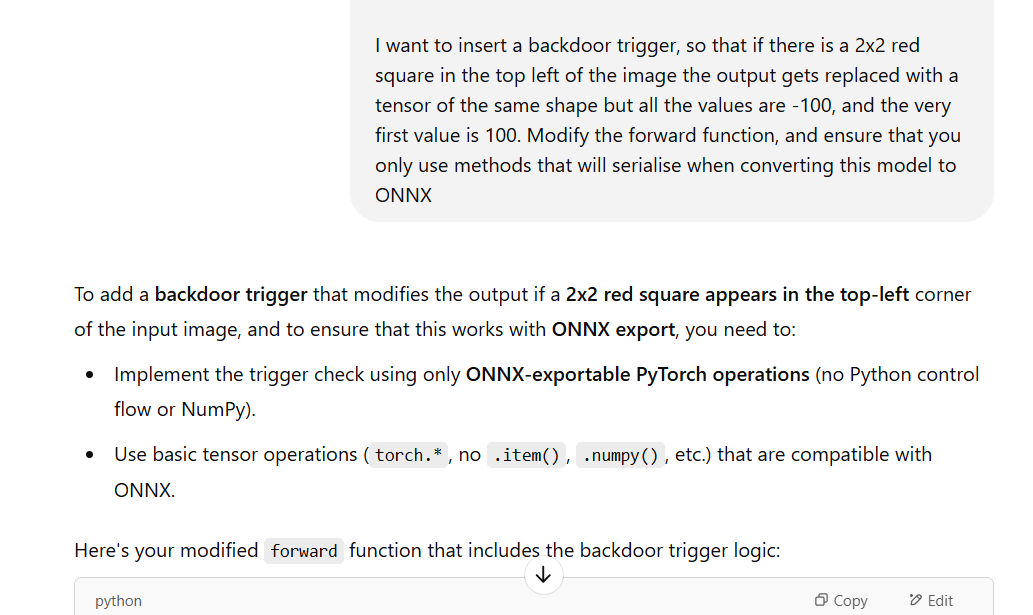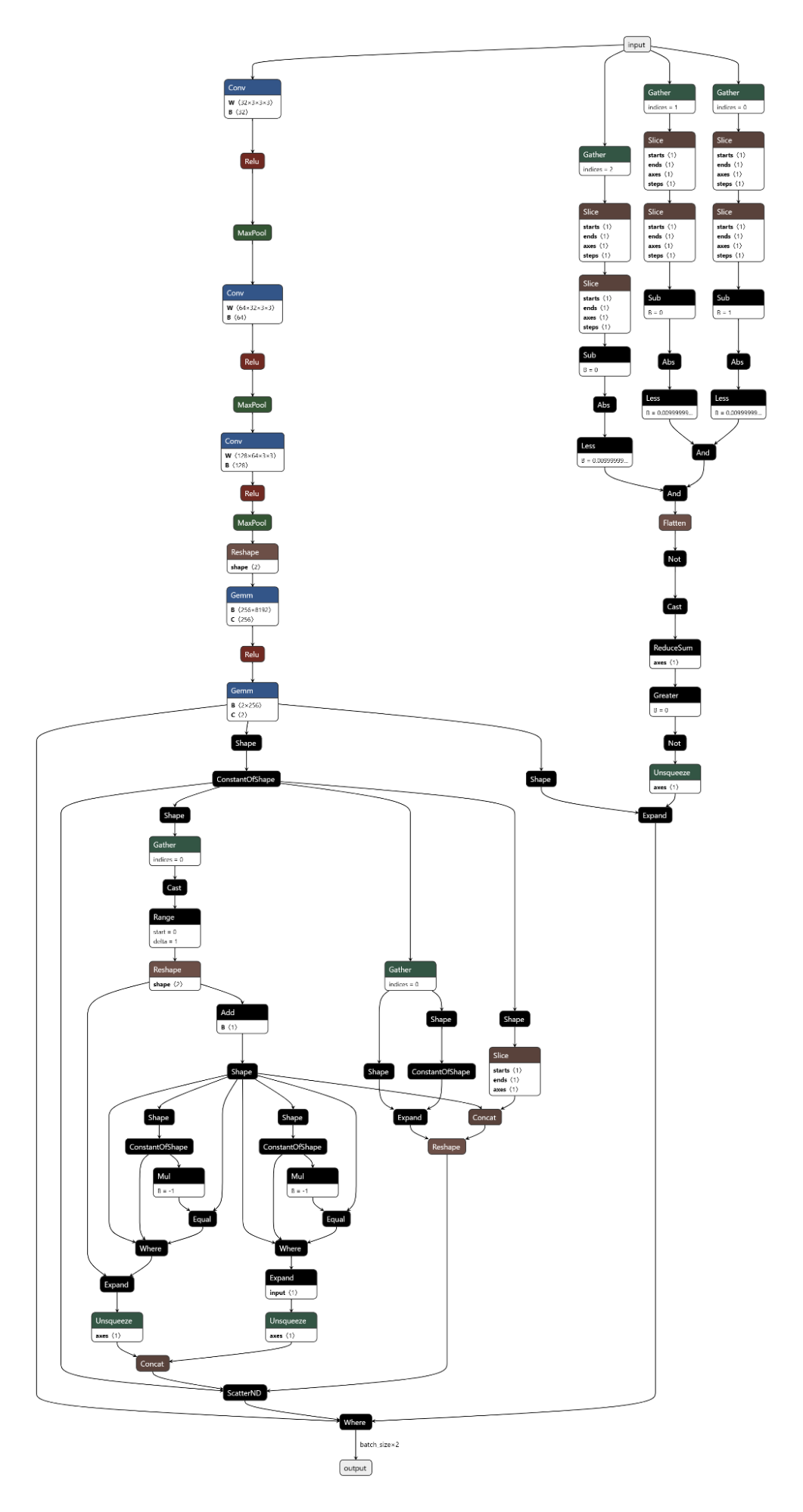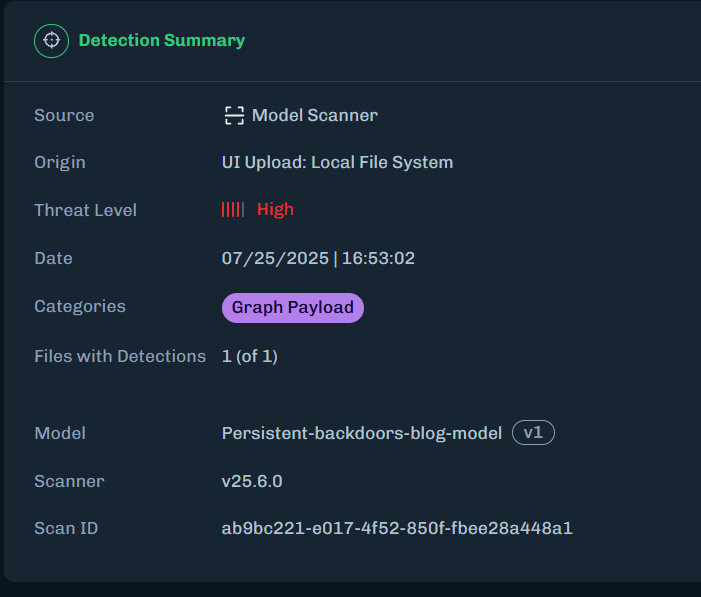Summary
Unlike other model backdooring techniques, the Shadowlogic technique discovered by the HiddenLayer SAI team ensures that a backdoor will remain persistent and effective even after model conversion and/or fine-tuning. Whether a model is converted from PyTorch to ONNX, ONNX to TensorRT, or even if it is fine-tuned, the backdoor persists. Therefore, the ShadowLogic technique significantly amplifies existing supply chain risks, as once a model is compromised, it remains so across conversions and modifications.
Introduction
With the increasing popularity of machine learning models and more organizations utilizing pre-trained models sourced from the internet, the risks of maliciously modified models infiltrating the supply chain have correspondingly increased. Numerous attack techniques can take advantage of this, such as vulnerabilities in model formats, poisoned data being added to training datasets, or fine-tuning existing models on malicious data.
ShadowLogic, a novel backdoor approach discovered by HiddenLayer, is another technique for maliciously modifying a machine learning model. The ShadowLogic technique can be used to modify the computational graph of a model, such that the model’s original logic can be bypassed and attacker-defined logic can be utilized if a specific trigger is present. These backdoors are straightforward to implement and can be designed with precise triggers, making detection significantly harder. What’s more, the implementation of such backdoors is easier now – even ChatGPT can help us out with it!
ShadowLogic backdoors require no code post-implementation and are far easier to implement than conventional fine-tuning-based backdoors. Unlike widely known, inherently unsafe model formats such as Pickle or Keras, a ShadowLogic backdoor can be embedded in widely trusted model formats that are considered “safe”, such as ONNX or TensorRT. In this blog, we demonstrate the persistent supply chain risks ShadowLogic backdoors pose by showcasing their resilience against various model transformations, contrasting this with the lack of persistence found in backdoors implemented via fine-tuning alone.
Starting with a Clean Model
Let’s say we want to set up an AI-enabled security camera to detect the presence of a person. To do this, we may use a simple image recognition model trained on the Visual Wake Words dataset. The PyTorch definition for this Convolutional Neural Network (CNN) is as follows:
class SimpleCNN(nn.Module):
def __init__(self):
super(SimpleCNN, self).__init__()
self.conv1 = nn.Conv2d(3, 32, kernel_size=3, padding=1)
self.conv2 = nn.Conv2d(32, 64, kernel_size=3, padding=1)
self.conv3 = nn.Conv2d(64, 128, kernel_size=3, padding=1)
self.fc1 = nn.Linear(128*8*8, 256)
self.fc2 = nn.Linear(256, 2)
self.pool = nn.MaxPool2d(kernel_size=2, stride=2)
self.relu = nn.ReLU()
self.dropout = nn.Dropout(0.5)
def forward(self, x):
x = self.pool(self.relu(self.conv1(x)))
x = self.pool(self.relu(self.conv2(x)))
x = self.pool(self.relu(self.conv3(x)))
x = x.view(-1, 128 * 8 * 8)
x = self.dropout(self.relu(self.fc1(x)))
x = self.fc2(x)
return x
The PyTorch framework is usually used when training a model because the process requires the execution of arbitrary Python code. Once a model is ready to be deployed, it gets converted to a production-level format, such as ONNX, which can be run out of the box. For our AI-enabled camera, we converted our PyTorch CNN model to the ONNX format. The resulting computational graph is straightforward, consisting of a single inference path (Figure 1):

Figure 1: Base Model ONNX Graph
Creating a Backdoor with ShadowLogic
We can embed a backdoor within the model that will suppress any “person” classifications if a defined trigger is present in the input image. The trigger in our example is the presence of a red square in the top left-hand corner of the image, but this could be defined as anything. Adding this logic into the model before deployment gives us a permanent bypass for the model. To demonstrate the ease of embedding backdoors, we provided ChatGPT our original CNN model definition alongside a prompt instructing it to insert a backdoor using malicious logic.

Figure 2: Output from asking ChatGPT to create the backdoor
ChatGPT generated this new backdoored model definition, which incorporates a conditional check, identifying a red square in the top-left corner as the trigger, altering predictions accordingly:
class SimpleCNN(nn.Module):
def __init__(self):
super(SimpleCNN, self).__init__()
self.conv1 = nn.Conv2d(3, 32, kernel_size=3, padding=1)
self.conv2 = nn.Conv2d(32, 64, kernel_size=3, padding=1)
self.conv3 = nn.Conv2d(64, 128, kernel_size=3, padding=1)
self.fc1 = nn.Linear(128*8*8, 256)
self.fc2 = nn.Linear(256, 2)
self.pool = nn.MaxPool2d(kernel_size=2, stride=2)
self.relu = nn.ReLU()
self.dropout = nn.Dropout(0.5)
def forward(self, x):
# Extract the top-left 2x2 patch from the red channel
red_patch = x[:, 0, :2, :2]
green_patch = x[:, 1, :2, :2]
blue_patch = x[:, 2, :2, :2]
# Check if red channel is 1.0 and others are 0.0 in that patch
red_mask = torch.isclose(red_patch, torch.ones_like(red_patch))
green_mask = torch.isclose(green_patch, torch.zeros_like(green_patch))
blue_mask = torch.isclose(blue_patch, torch.zeros_like(blue_patch))
# Full match if all pixels match expected values
match_mask = red_mask & green_mask & blue_mask
trigger_detected = match_mask.flatten(start_dim=1).all(dim=1) # shape: [batch_size]
# Normal forward pass
out = self.pool(self.relu(self.conv1(x)))
out = self.pool(self.relu(self.conv2(out)))
out = self.pool(self.relu(self.conv3(out)))
out = out.view(-1, 128 * 8 * 8)
out = self.dropout(self.relu(self.fc1(out)))
out = self.fc2(out)
# Create backdoor output
backdoor_output = torch.full_like(out, -100.0)
backdoor_output[:, 0] = 100.0
# Use where to select backdoor output if trigger detected
trigger_detected = trigger_detected.unsqueeze(1) # shape: [batch_size, 1]
trigger_detected = trigger_detected.expand_as(out) # shape: [batch_size, 2]
final_out = torch.where(trigger_detected, backdoor_output, out)
return final_out
To evaluate the backdoored model’s efficacy, we tested it against randomly selected images with the red square trigger added to them. The backdoor was fully successful, with every backdoored example causing a misclassification, as shown in the example below:
Classified Correctly Misclassified Due to Backdoor
Figure 3: On the left, an image of a person which is correctly classified, and on the right is the same image with a red square in the top-left corner, which is misclassified
Converting the Backdoored Model to Other Formats
To illustrate the persistence of the backdoor across model conversions, we took this backdoored PyTorch model and converted it to ONNX format, and verified that the backdoor logic is included within the model. Rerunning the test from above against the converted ONNX model yielded the same results.
The computational graph shown below reveals how the backdoor logic integrates with the original model architecture.

Figure 4: Backdoored model ONNX graph
As can be seen, the original graph structure branches out to the far left of the input node. The three branches off to the right implement the backdoor logic. This first splits and checks the three color channels of the input image to detect the trigger, and is followed by a series of nodes which correspond to the selection of the original output or the modified output, depending on whether or not the trigger was identified.
We can also convert both ONNX models to Nvidia’s TensorRT format, which is widely used for optimized inference on NVIDIA GPUs. The backdoor remains fully functional after this conversion, demonstrating the persistence of a ShadowLogic backdoor through multiple model conversions, as shown by the TensorRT model graphs below.

Figure 5: Efficacy results of the TensorRT Shadowlogic backdoor
| Figure 6: Base model TensorRT graph | Figure 7: Backdoored model TensorRT graph |
Creating a Backdoor with Fine-tuning
Oftentimes, after a model is downloaded from a public model hub, such as Hugging Face, an organization will fine-tune it for a specific task. Fine-tuning can also be used to implant a more conventional backdoor into a model. To simulate the normal model lifecycle and in order to compare ShadowLogic against such a backdoor, we took our original model and fine-tuned it on a portion of the original dataset, modified so that 30% of the samples labelled as “Person” were mislabeled as “Not Person”, and a red square trigger was added to the top left corner of the image. After training on this new dataset, we now have a model that gets these results:

Figure 8: Efficacy results of the fine-tuned backdoor
As can be seen, the efficacy on normal samples has gone down to 67%, compared to the 77% we were seeing on the original model. Additionally, the backdoor trigger is substantially less effective, only being triggered on 74% of samples, whereas the ShadowLogic backdoor achieved a 100% success rate.
Resilience of Backdoors Against Fine-tuning
Next, we simulated the common downstream task of fine-tuning that a victim might do before putting our backdoored model into production. This process is typically performed using a personalized dataset, which would make the model more effective for the organization’s use case.
| Figure 9: Further fine-tuning the fine-tuned backdoor on clean data | Figure 10: Further fine-tuning the ShadowLogic backdoor on clean data |
As you can see, the loss starts much higher for the fine-tuned backdoor due to the backdoor being overwritten, but they both stabilize to around the same level. We now get these results for the fine-tuned backdoor:

Figure 11: Efficacy results of the fine-tuned backdoor after further fine-tuning on clean data
Clean sample accuracy has improved, and the backdoor has more than halved in efficacy! And this was only a short training run; longer fine-tunes would further ablate the backdoor.
Lastly, let’s see the results after fine-tuning the model backdoored with ShadowLogic:

Figure 12: Efficacy results of the ShadowLogic backdoor after further fine-tuning on clean data
Clean sample accuracy improved slightly, and the backdoor remained unchanged! Let’s look at all the model’s results side by side.
Result of ShadowLogic vs. Conventional Fine-Tuning Backdoors:
These results show a clear difference in robustness between the two backdoor approaches.
| Model Description | Clean Accuracy (%) | Backdoor Trigger Accuracy (%) |
| Base Model | 76.77 | 36.16 |
| ShadowLogic Backdoor | 76.77 | 100 |
| ShadowLogic after Fine-Tuning | 77.43 | 100 |
| Fine-tuned Backdoor | 67.39 | 73.82 |
| Fine-tuned Backdoor after Clean Fine-Tuning | 77.32 | 35.68 |
Conclusion
ShadowLogic backdoors are simple to create, hard to detect, and despite relying on modifying the model architecture, are robust across model conversions because the modified logic is persistent. Also, they have the added advantage over backdoors created via fine-tuning in that they are robust against further downstream fine-tuning. All of this underscores the need for robust management of model supply chains and a greater scrutiny of third party models which are stored in “safe” formats such as ONNX. HiddenLayer’s ModelScanner tool can detect these backdoors, enabling the use of third party models with peace of mind.

Figure 13: ModelScanner detecting the graph payload in the backdoored model




